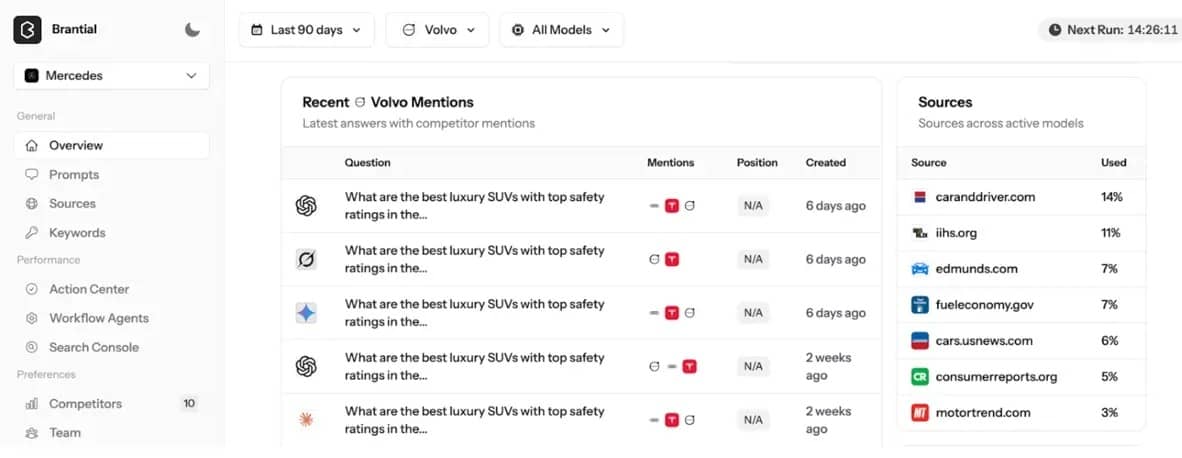What Is AI Visibility? How Do I Measure It?
Discover how AI visibility defines success in the era of generative search and how to measure and improve it across platforms.
AI visibility is emerging as the new frontier of digital dominance, redefining how brands are discovered and trusted across intelligent platforms.
What Is AI Visibility?
AI visibility refers to how prominently a brand, website, or piece of content appears within AI-powered search environments and generative platforms. Unlike traditional SEO, which focuses on visibility within standard search engine results pages, AI visibility spans generative AI answers (ChatGPT, Gemini, Perplexity), voice assistants (Alexa, Siri), and algorithmically curated feeds on social platforms such as TikTok or Instagram.
These systems rely on large language models and machine learning to deliver contextually relevant results. Semantic relevance, entity recognition, structured content, and trust signals become critical ingredients if you want AI systems to understand and surface your brand.
Why AI Visibility Matters for Modern Brands
AI-driven experiences are now the gatekeepers of online exposure. As users rely on AI search, chat, and recommendation engines to make decisions, brands that fail to show up in those answers fall out of the conversation entirely.
- AI platforms shape awareness, conversions, and loyalty by recommending products and services.
- Users increasingly trust AI responses for comparisons and purchase decisions.
- Being cited in an AI-generated answer often has more influence than ranking first on a conventional SERP.
How Does AI Visibility Work Across Platforms?
AI visibility now stretches well beyond the ten blue links. Each platform processes data differently, so your presence depends on how well AI systems can understand, contextualize, and trust your content.
AI Search Engines and Generative Results (ChatGPT, Perplexity, Gemini)
Generative AI tools summarize, synthesize, and deliver direct answers—frequently naming brands, products, or articles. To earn inclusion, your content must be semantically rich, clearly formatted, and backed by credible signals that establish topical authority.
How Google SGE (Search Generative Experience) Affects Visibility
Google SGE blends generative overviews with traditional listings, pulling concise summaries into the top of the results page. Brands that appear in those overviews benefit from immediate exposure, while those missing out see declining clicks. Structured data, authoritative content, and entity optimization improve the chances of being featured.
Social and Voice AI Platforms (TikTok AI, Alexa, Chatbots)
Social recommenders, voice assistants, and embedded chatbots rely on entity recognition, metadata, and user engagement to decide which brands to surface. Consistency across profiles, product feeds, and conversational copy helps AI agents understand your offering and present it to the right audiences.
Key Factors That Influence AI Visibility
Content Relevance and Semantic Context
AI systems map questions to intent. Content that mirrors the language of user queries, offers in-depth answers, and provides supporting context is more likely to be cited.
Structured Data and AI Readability
Schema markup, clean metadata, and machine-readable product details help AI interpret and reuse your information accurately across interfaces.
E-E-A-T and Trust Signals
Expertise, experience, authoritativeness, and trustworthiness remain foundational. Verified authorship, reputable backlinks, and transparent sourcing reassure AI engines that your content is reliable.
Brand Mentions and Entity Optimization
Consistent brand mentions, entity linking, and knowledge graph alignment strengthen AI’s understanding of who you are and why you matter within a topic.
How to Measure AI Visibility Effectively
Traditional analytics only tell part of the story. Combine multiple data sources to gauge how frequently AI systems surface your brand.
1. Use SEMrush to Track Keyword and SERP Visibility
Monitor emerging AI-powered SERP features and keyword positions to understand where generative summaries overlap with your content.
2. Use Google Analytics to Measure AI-Driven Referral Traffic
Annotate traffic spikes from AI-integrated platforms, track attribution from new referral sources, and analyze assisted conversions tied to AI interactions.
3. Use Brantial to Measure AI Mentions and Prompt Inclusion
Brantial gives direct insight into how often AI engines mention your brand, which prompts trigger your inclusion, and where competitors are gaining share. Use these insights to prioritize content and messaging opportunities.

How to Improve AI Visibility
1. Optimize for Conversational and Intent-Based Queries
Structure content to answer full-sentence questions and multi-intent prompts. Include FAQs, comparisons, and scenario-based explanations that match how people speak to AI assistants.
2. Strengthen Entity Recognition and Structured Data
Ensure your brand, products, and experts are clearly defined with schema markup, consistent naming, and complete metadata across channels.
3. Build Trust with E-E-A-T Signals
Highlight credentials, cite reputable sources, and maintain up-to-date information. Encourage reviews, showcase case studies, and publish original research to reinforce authority.
4. Produce Rich, Multi-Format Content
Blend articles, videos, podcasts, and interactive visuals so AI systems have multiple high-quality assets to reference. Multimodal content supports discovery across voice, social, and generative platforms.
5. Use Tools That Optimize for AI Discovery
Adopt platforms that monitor AI citations, analyze prompt-level visibility, and surface new opportunities. Continuous optimization keeps your brand visible as AI experiences evolve.
In the age of intelligent discovery, AI visibility determines whether your brand is recommended, trusted, and remembered. Measure it proactively, refine your signals, and stay ahead as generative platforms reshape the customer journey.